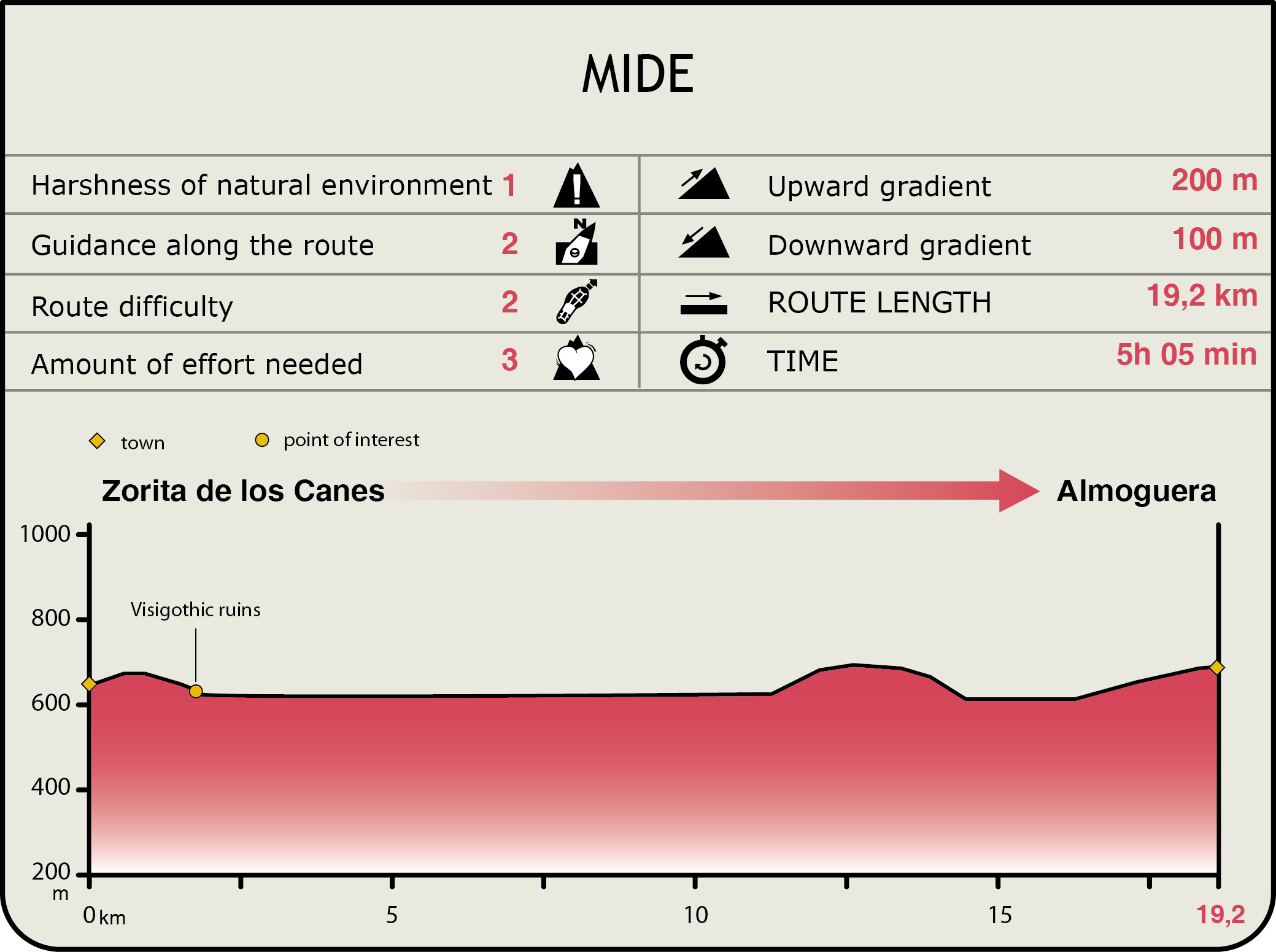Net of Natural
Trails

Stage 15: Zorita de los Canes - Almoguera
Description
Walking through groves along the River Tagus
This Stage leaves behind the town of Zorita de los Canes and its beautiful ruins to venture along the Tagus along riverside paths surrounded by giant reeds. The route heads to the village of Almoguera, with a rich historical heritage, which is manifested in the ruins of an ancient castle.
The route heads out of Zorita de los Canes, skirting around the old Mozarab castle (please refer to Stage 14), where the traveller can see the wonderful ruins in all their glory. Crossing to the opposite side of the road, the path climbs up the hill adjacent to the town. By looking back during the climb, one can enjoy a panoramic view of the castle with the side buttress. The view from here is truly impressive.
This Stage proceeds to the Visigoth ruins of Recópolis where an interpretation centre can be found. This track leads back to a landscape of olive groves (Olea europaea).
The route continues to zigzag down the hill. From here starts a spectacular stretch that runs along the Reserva Fluvial de los Sotos del Río Tajo. Most of this Stage winds through the “Sierra de Altamira” Site of Community Importance (SCI) and Special Protection Area for Birds (SPA). The path runs just a few metres from the riverbed, where you can observe wildlife close-up, especially birds. The Trail proceeds confined by giant reeds (Arundo donax), with a few scattered beehives. The path leaves the road, crossing to the opposite side at the bend, and continues to wind parallel to the river.
Several kilometres further on, the path reaches a junction from where the traveller may visit the town of Albalate de Zorita taking the offshoot road. This solitary and narrow road to the town is flanked by olive groves. A derelict shrine to St. John the Baptist (1611), welcomes the visitor to the town, where a fountain and some shade provide respite. This offshoot road is 4.3 km long.
Back on the main road, once near the river, it continues along a colourful riverside promenade that gradually drifts away into farmland. However, it first passes next to the shrine of Santa Cruz de San Pedro, with a shaded rest area equipped with benches. From this vantage point, one can see how sparsely populated with trees the Trail is, therefore, it is advisable to stock up on water.
The path gradually approaches a large bend in the river, which it crosses via a winding track, to the left, that climbs up the hill. A breathtaking view can be seen from here.
From here the road heads down to the interStage where Stages 15 and 16 run together along a canal off Almoguera Reservoir. The path reaches the GU-249, which first crosses the canal, then turns right and runs across Almoguera Reservoir. Caution should be exercised when crossing, using only the available walkway.
The Stage along the GU-249 is short. Merely 300 m from the reservoir, the path turns left first, then right towards the town of Almoguera. The Church of Christ and the castle that crowns the town can be seen from three-kilometres before the Stage ends.
The narrow streets of Almoguera welcome the visitor with its shade and fountains. The ruins of the castle and the Church of Christ can be accessed from the village.
Profile

Highlights
Further information
Reserva fluvial de los sotos del río Tajo
This is a protected nature area located in a well-preserved riparian forest were tamarisks (Tamarix spp.) clearly dominate the landscape, together with mallards(Anas platyrhynchos), herons(Ardeidae), Great Crested Grebes (Podiceps cristatus) and other beautiful waterfowl.
Visigoth ruins of Recópolis
The only newly founded Visigoth town in Europe (Declared a Historical-Artistic Site in 1946) lies atop Oliva Hill, in the municipality of Zorita de los Canes. The archaeological remains of the Visigoth town of Recópolis (6th century), built by King Liuvigild for his son Recaredo, are located in Sierra de Enmedio. The city, where ceramics and utensils from the period were unearthed, has a wall and about a hundred buildings.
It was built in 578 A.D. after the military campaign at Oróspeda. This city was significant in its time, and even minted its own coins. Worthy of note are its dimension (thirty acres) and the early Christian basilica, built in two distinct phases, first as a 4th century Roman church, and later, as a basilica when the ancient Hispano-Roman settlement became a city. Other buildings of interest include walls, aqueduct, residential area, and streets.
It is currently part of the Network of Castile-La Mancha Archaeological Parks, with an on-site interpretation centre.
Tfno:949 376 898 http://www.patrimoniohistoricoclm.es


